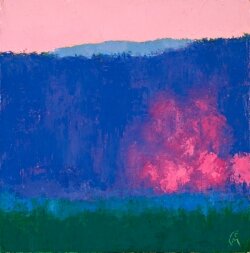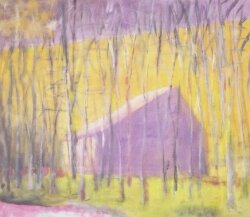Wolf on the horizon: McCarthy channels Kahn landscapes
“There's nothing new under the sun” and “Imitation is the sincerest form of flattery” are two sayings repeated whenever an artist’s work is deemed derivative. Any creative type— whether a painter, writer, or musician— has his or her heroes. Often an idol's style gets incorporated, sometimes consciously, sometimes un- , into the work of the admirer. But what separates influence from imitation? And does mimicry matter if the work is good?
Such questions are unavoidable when viewing Les Yeux du Monde’s current exhibit, “John McCarthy: A Retrospective,” which features oils, pastels, and mixed-media paintings by retired attorney general-turned-artist McCarthy, who died in 2008. Vibrant semi-abstract landscapes predominate in the 98 works hanging salon-style in two tiers around the gallery. And anyone with a passing familiarity with contemporary painting will walk into Les Yeux du Monde and immediately think, “Wolf Kahn.”
Which is not surprising since McCarthy studied under Kahn. But what raises eyebrows is how little McCarthy’s style varies from his teacher’s aesthetic. Like Kahn, McCarthy interprets landscapes in dazzling colors that are more emotive than realistic. Skies become neon orange, wooded hillsides violet. Geometric shapes and expressionistic color fields take precedence over articulated details. McCarthy’s treatment of trees is almost identical to Kahn’s, in some works depicting them as vertical lines while elsewhere using quick, layered brushstrokes to create a blur of branches and leaves.
This replication is particularly apparent in McCarthy’s paintings of buildings, where he reproduces angles and perspectives favored by Kahn. In “Our Saltbox Before Dawn,” McCarthy uses the same gray-lilac shade and basic composition of Kahn’s famous painting, “Saltbox Barn.” The difference is McCarthy’s work is monochromatic, whereas Kahn placed his barn against a background of yellow woods.
Interestingly, McCarthy’s earliest works, displayed just inside the gallery entrance, show the most originality. “Piedmont Rebus II” offers an oil pastel mosaic of nine panels, each resembling a small abstract landscape. The color relationships and movement of lines from one square to the next, both vertically and horizontally, are captivating. Also, McCarthy’s colorful figure studies and sketchbooks, on view in the back of the gallery, provide a welcome break from his all-Kahn-all-the-time approach.
Though derivative, McCarthy’s paintings are nevertheless beautiful. In India, 16th-18th century poets often signed their verses with the names of famous writers like Kabir or Tulsidas, hoping their work would be indistinguishable from that of the virtuosos’. In this way, McCarthy succeeds, doing Wolf Kahn proud.
“John McCarthy: A Retrospective” is on view through June 5 at Les Yeux du Monde, 841 Wolf Trap Road. 973-5566.

